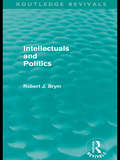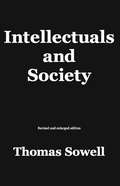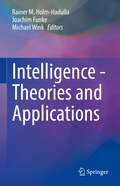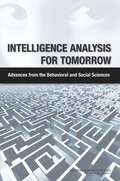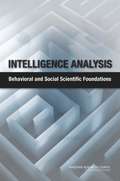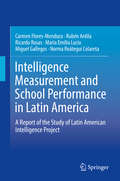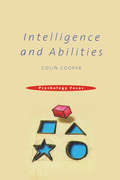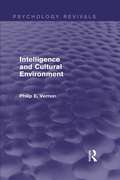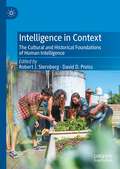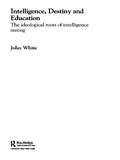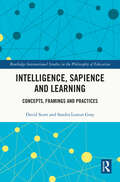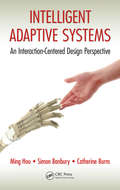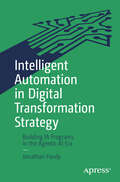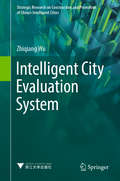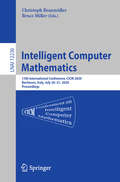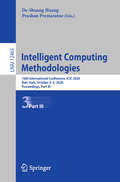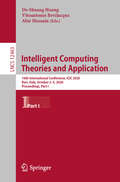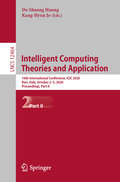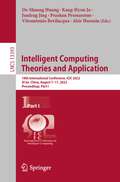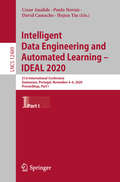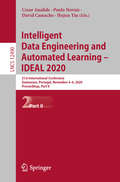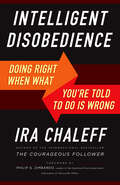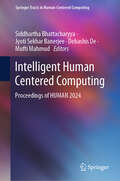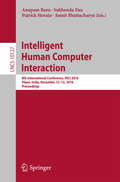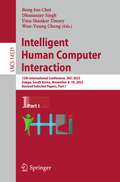- Table View
- List View
Intellectuals and Politics (Routledge Revivals #Vol. 9)
by Robert BrymThis essay, first published in 1980, analyses the relationship between intellectuals’ social locations and their political orientations. Dr Brym provides a critical discussion of the various sociological views of intellectuals and specifies some of the social conditions which encourage intellectuals to follow various directions on the political compass. He also demonstrates that intellectuals are neither socially rootless nor tied to one particular class or group within society, concluding that it is only by an analysis of intellectuals’ mobility patterns that we can hope to arrive at an adequate understanding of their politics. Clearly written, and assuming only a basic grounding in sociological theory, this book will thus be of special interest to students of political sociology, social movements, the sociology of knowledge, the sociology of culture and the sociology of intellectuals.
Intellectuals and Society
by Thomas SowellHow intellectuals as a class affect modern societies by shaping the climate of opinion in which official policies develop--on issues ranging from economics to law to war and peace
Intelligence - Theories and Applications
by Michael Wink Joachim Funke Rainer M. Holm-HadullaIntelligence allows people to understand events and to shape their surrounding environment. This book delves deeper into the theories and applications of intelligence, showing it is a multifaceted concept —defined and explained differently by prestigious experts of various disciplines in their own research. The book provides interdisciplinary connections of intelligence as it relates to a variety of clearly outlined subject areas, and should lead to a deep understanding of the phenomenon as it pertains to practical applications in different domains. Contributors in this volume present results from evolutionary biology, mathematics, artificial intelligence, medicine, psychology, cultural studies, economy, political sciences and philosophy. Individual scientific models are integrated in an interdisciplinary concept of wisdom. This volume will help enhance the common understanding of intelligence for fellow researchers and scientists alike.
Intelligence Analysis for Tomorrow: Advances from the Behavioral and Social Sciences
by National Research Council of the National AcademiesThe intelligence community (IC) plays an essential role in the national security of the United States. Decision makers rely on IC analyses and predictions to reduce uncertainty and to provide warnings about everything from international diplomatic relations to overseas conflicts. In today's complex and rapidly changing world, it is more important than ever that analytic products be accurate and timely. Recognizing that need, the IC has been actively seeking ways to improve its performance and expand its capabilities. In 2008, the Office of the Director of National Intelligence (ODNI) asked the National Research Council (NRC) to establish a committee to synthesize and assess evidence from the behavioral and social sciences relevant to analytic methods and their potential application for the U.S. intelligence community. In Intelligence Analysis for Tomorrow: Advances from the Behavioral and Social Sciences, the NRC offers the Director of National Intelligence (DNI) recommendations to address many of the IC's challenges. Intelligence Analysis for Tomorrow asserts that one of the most important things that the IC can learn from the behavioral and social sciences is how to characterize and evaluate its analytic assumptions, methods, technologies, and management practices. Behavioral and social scientific knowledge can help the IC to understand and improve all phases of the analytic cycle: how to recruit, select, train, and motivate analysts; how to master and deploy the most suitable analytic methods; how to organize the day-to-day work of analysts, as individuals and teams; and how to communicate with its customers. The report makes five broad recommendations which offer practical ways to apply the behavioral and social sciences, which will bring the IC substantial immediate and longer-term benefits with modest costs and minimal disruption.
Intelligence Analysis: Behavioral and Social Scientific Foundations
by National Research Council of the National AcademiesThe U.S. intelligence community (IC) is a complex human enterprise whose success depends on how well the people in it perform their work. Although often aided by sophisticated technologies, these people ultimately rely on their own intellect to identify, synthesize, and communicate the information on which the nation's security depends. The IC's success depends on having trained, motivated, and thoughtful people working within organizations able to understand, value, and coordinate their capabilities. Intelligence Analysis provides up-to-date scientific guidance for the intelligence community (IC) so that it might improve individual and group judgments, communication between analysts, and analytic processes. The papers in this volume provide the detailed evidentiary base for the National Research Council's report, Intelligence Analysis for Tomorrow: Advances from the Behavioral and Social Sciences. The opening chapter focuses on the structure, missions, operations, and characteristics of the IC while the following 12 papers provide in-depth reviews of key topics in three areas: analytic methods, analysts, and organizations. Informed by the IC's unique missions and constraints, each paper documents the latest advancements of the relevant science and is a stand-alone resource for the IC's leadership and workforce. The collection allows readers to focus on one area of interest (analytic methods, analysts, or organizations) or even one particular aspect of a category. As a collection, the volume provides a broad perspective of the issues involved in making difficult decisions, which is at the heart of intelligence analysis.
Intelligence Measurement and School Performance in Latin America: A Report of the Study of Latin American Intelligence Project
by Carmen Flores-Mendoza Rubén Ardila Ricardo Rosas María Emilia Lucio Miguel Gallegos Norma Reátegui ColaretaThis book presents the results of the most complete and updated assessment of cognitive resources of students in Latin America: the Study of Latin American Intelligence (SLATINT). During four years, top researchers of the region used a standardized set of cognitive measures to assess 4,000 students aged between 14 and 15 years from six countries: Brazil, Argentina, Mexico, Chile, Colombia and Peru. The data collected and now analyzed in this volume is a first step to understand the human cognitive capital of the region, a crucial resource for any country today. Intelligence research has shown that the cognitive skills of a population are strongly associated with the school performance of its students and the development of a nation. This makes Intelligence Measurement and School Performance in Latin America a valuable tool both for Latin American researchers and authorities engaged in the improvement of each country’s human resources and for psychologists, educators and other social scientists dedicated to the study of the impact of intelligence in the development of nations.
Intelligence and Abilities
by Colin CooperResearch into abilities is one of the great success stories of psychology. Ability tests are widely used and there is continued interest in the origins of abilites (enes or environment?) and their links to social phenomena such as crime and welfare dependecy. Intelligence and Abilities explains what is known about the processes associated with mental abilities and the relationship of abilities to behaviour. It also provides a clear and up-to-date guide to the main areas of research.
Intelligence and Cultural Environment (Psychology Revivals)
by Philip E. VernonOriginally published in 1969, Intelligence and Cultural Environment looks at the concept of intelligence and the factors influencing the mental development of children, including health and nutrition, as well as child-rearing practices. It goes on to discuss the application of intelligence tests in non-Western countries and includes both British and cross-cultural studies to illustrate this. Inevitably a product of the time in which it was written, this book nonetheless makes a valuable contribution to intelligence theory as we know it today.
Intelligence in Context: The Cultural and Historical Foundations of Human Intelligence
by Robert J. Sternberg David D. PreissThis book reflects on the various ways in which intelligence can manifest itself in the wide range of diverse contexts in which people live. Intelligence is often viewed as being tantamount to a score or set of scores on a decontextualized standardized intelligence test. But intelligence always acts within a sociocultural context. Indeed, early theorists defined intelligence in terms of adaptation to the environment in which one lives. The tradition of decontextualization is old, dating back to the very beginning of the 20th century with the development of the Binet-Simon Intelligence Scales. This tradition is not only old, however, but obsolete. Because people live in different sociocultural as well as physical environments, intelligence can take somewhat different forms in different places and even at different times. The chapters in this edited volume show that intelligence viewed in the abstract is a somewhat vacuous concept - it needs to be contextualized in terms of people’s physical and sociocultural surroundings.
Intelligence, Destiny and Education: The Ideological Roots of Intelligence Testing
by John WhiteThe nature of intelligence and how it can be measured has occupied psychologists, educationalists, biologists and philosophers for hundreds of years. However, there has been little investigation into the rise of the traditional dominant educational ideology that intelligence and IQ have innate limits and are unchanging and unchangeable. This book traces the roots of this mind set back to early puritan communities on both sides of the Atlantic, drawing parallels between puritan dogma and the development of the traditional curricula and selection processes that are still firmly embedded in school practice today. Drawing on the work of Galton, Pearson, Burt, Goddard, Terman and others in his search for the truth about intelligence testing, John White looks at the personal histories and socialised religious backgrounds of these key psychologists and casts an entirely new light on schooling in Britain and the USA in modern times. This work also shows how we can transcend this heritage and base our educational system on values and practices more in tune with the twenty-first century.
Intelligence, Sapience and Learning: Concepts, Framings and Practices (Routledge International Studies in the Philosophy of Education)
by David Scott Sandra Leaton GrayExamining the idea of intelligence in its diverse sociological and philosophical formations, Intelligence, Sapience and Learning explores the multiple and often complex meanings associated with the concept of intelligence, and its relationships with learning, curriculum and sapience. Scott and Leaton Gray explain a series of key concepts central to understanding the meta-concepts and practices of intelligence, learning and curriculum. These concepts include epistemology, free will and volition, hermeneutics, pragmatism, strong normative evaluations and pedagogy, amongst others. Focusing on six praxes that form a genealogy of the concept of intelligence, Scott and Leaton Gray argue for a re-framing of the concept and practice of intelligence, with profound consequences for how modern societies should be organised and how people should live their lives. This book is a follow-up to Women Curriculum Theorists: Power, Knowledge and Subjectivity, and takes a fresh look at the concept and practice of intelligence. It will appeal to curriculum theorists and those with an interest in curriculum and learning matters, as well as those working in the philosophy and sociology of education.
Intelligent Adaptive Systems: An Interaction-Centered Design Perspective
by Catherine Burns Simon Banbury Ming HouAs ubiquitous as the atmosphere, intelligent adaptive systems (IASs) surround us in our daily lives. When designed well, these systems sense users and their environments so that they can provide support in a manner that is not only responsive to the evolving situation, but unnoticed by the user. A synthesis of recent research and developments on IASs from the human factors (HF) and human–computer interaction (HCI) domains, Intelligent Adaptive Systems: An Interaction-Centered Design Perspective provides integrated design guidance and recommendations for researchers and system developers. The book explores a recognized lack of integration between the HF and HCI research communities, which has led to inconsistencies between the research approaches adopted, and a lack of exploitation of research from one field by the other. The authors integrate theories and methodologies from these domains to provide design recommendations for human–machine developers. They then establish design guidance through the review of conceptual frameworks, analytical methodologies, and design processes for intelligent adaptive systems. The book draws on case studies from the military, medical, and distance learning domains to illustrate intelligent system design to examine lessons learned.Outlining an interaction-centered perspective for designing an IAS, the book details methodologies for understanding human work in complex environments and offers understanding about why and how optimizing human–machine interaction should be central to the design of IASs. The authors present an analytical and design methodology as well as an implementation strategy that helps you choose the proper design framework for your needs.
Intelligent Automation in Digital Transformation Strategy: Building IA Programs in the Agentic AI Era
by Jonathan HardyHarness the full potential of Intelligent Automation (IA) to transform your businesses, stay competitive, and navigate the complexities of today&’s digital landscape. This book is a comprehensive guide for business leaders, executives, and automation professionals, exploring how Intelligent Automation (IA) has evolved from traditional Robotic Process Automation (RPA) to become a powerful catalyst in Digital Transformation. Begin with the fundamentals of IA and its progression from simple, rule-based RPA to advanced IA, incorporating AI-driven technologies like Machine Learning, Generative AI, and Agentic AI. These emerging technologies empower organizations to tackle more complex processes, enabling intelligent decision-making and enhanced customer interactions prompting the necessity for robust governance and alignment with broader business objectives, which is a primary focus of this book. To combat that, you&’ll review actionable frameworks and governance models designed to support the development and sustainability of IA programs at scale. The book provides a structured roadmap to establish an IA Center of Excellence (CoE), ensuring that automation efforts align with the organization&’s Digital Transformation goals. By integrating governance processes, risk management, and best practices, you&’ll be able to build IA initiatives that are resilient, compliant, and strategically impactful. Intelligent Automation for Digital Transformation demystifies the journey to becoming a digitally native organization. Who This Book is For Leaders responsible for shaping their organization&’s long-term strategy, digital innovation, and business process efficiency agenda. Executives in the financial services, healthcare, and other highly regulated industries where a risk management mindset and proper governance framework is key. Consultants and advisors within the business transformation and automation space who are ena-bling companies in their journey to become digitally native.
Intelligent City Evaluation System (Strategic Research on Construction and Promotion of China's Intelligent Cities)
by Zhiqiang WuThis book assesses various intelligent-city evaluation systems around the globe, and subsequently combines that assessment with local-government and enterprise practices to create an evaluation index system for quantifying the Intelligent City concept. In addition, the book provides the results of the CityIQ indicator ranking of intelligent cities in China and worldwide, a system that focuses on three of the most crucial aspects of urban development: the development environment, future trends, and construction and operation. After data sorting, calculation and dimensionless treatment, a score system ranging from 0 to 100 is created for ranking and analyzing cities. Providing unique strategies for promoting an intelligent city evaluation system, the book offers a valuable reference guide for intelligent-city decision-makers, as well as leaders in public urban economy, social welfare and environmental authorities.
Intelligent Computer Mathematics: 13th International Conference, CICM 2020, Bertinoro, Italy, July 26–31, 2020, Proceedings (Lecture Notes in Computer Science #12236)
by Bruce Miller Christoph BenzmüllerThis book constitutes the refereed proceedings of the 13th International Conference on Intelligent Computer Mathematics, CICM 2020, held in Bertinoro, Italy, in July 2020*.The 15 full papers, 1 invited paper and 2 abstracts of invited papers presented were carefully reviewed and selected from a total of 35 submissions. The papers focus on advances in automated theorem provers and formalization, computer algebra systems and their libraries, and applications of machine learning, among other topics. * The conference was held virtually due to the COVID-19 pandemic.
Intelligent Computing Methodologies: 16th International Conference, ICIC 2020, Bari, Italy, October 2–5, 2020, Proceedings, Part III (Lecture Notes in Computer Science #12465)
by Prashan Premaratne De-Shuang HuangThis two-volume set of LNCS 12463 and LNCS 12464 constitutes - in conjunction with the volume LNAI 12465 - the refereed proceedings of the 16th International Conference on Intelligent Computing, ICIC 2020, held in Bari, Italy, in October 2020. The 162 full papers of the three proceedings volumes were carefully reviewed and selected from 457 submissions. The ICIC theme unifies the picture of contemporary intelligent computing techniques as an integral concept that highlights the trends in advanced computational intelligence and bridges theoretical research with applications. The theme for this conference is “Advanced Intelligent Computing Methodologies and Applications.” Papers related to this theme are especially solicited, addressing theories, methodologies, and applications in science and technology.
Intelligent Computing Theories and Application: 16th International Conference, ICIC 2020, Bari, Italy, October 2–5, 2020, Proceedings, Part I (Lecture Notes in Computer Science #12463)
by De-Shuang Huang Abir Hussain Vitoantonio BevilacquaThis two-volume set of LNCS 12463 and LNCS 12464 constitutes - in conjunction with the volume LNAI 12465 - the refereed proceedings of the 16th International Conference on Intelligent Computing, ICIC 2020, held in Bari, Italy, in October 2020. The 162 full papers of the three proceedings volumes were carefully reviewed and selected from 457 submissions. The ICIC theme unifies the picture of contemporary intelligent computing techniques as an integral concept that highlights the trends in advanced computational intelligence and bridges theoretical research with applications. The theme for this conference is “Advanced Intelligent Computing Methodologies and Applications.” Papers related to this theme are especially solicited, addressing theories, methodologies, and applications in science and technology.
Intelligent Computing Theories and Application: 16th International Conference, ICIC 2020, Bari, Italy, October 2–5, 2020, Proceedings, Part II (Lecture Notes in Computer Science #12464)
by De-Shuang Huang Kang-Hyun JoThis two-volume set of LNCS 12463 and LNCS 12464 constitutes - in conjunction with the volume LNAI 12465 - the refereed proceedings of the 16th International Conference on Intelligent Computing, ICIC 2020, held in Bari, Italy, in October 2020. The 162 full papers of the three proceedings volumes were carefully reviewed and selected from 457 submissions. The ICIC theme unifies the picture of contemporary intelligent computing techniques as an integral concept that highlights the trends in advanced computational intelligence and bridges theoretical research with applications. The theme for this conference is “Advanced Intelligent Computing Methodologies and Applications.” Papers related to this theme are especially solicited, addressing theories, methodologies, and applications in science and technology.
Intelligent Computing Theories and Application: 18th International Conference, ICIC 2022, Xi'an, China, August 7–11, 2022, Proceedings, Part I (Lecture Notes in Computer Science #13393)
by Prashan Premaratne De-Shuang Huang Kang-Hyun Jo Abir Hussain Vitoantonio Bevilacqua Junfeng JingThis two-volume set of LNCS 13393 and LNCS 13394 constitutes - in conjunction with the volume LNAI 13395 - the refereed proceedings of the 18th International Conference on Intelligent Computing, ICIC 2022, held in Xi'an, China, in August 2022. The 209 full papers of the three proceedings volumes were carefully reviewed and selected from 449 submissions.This year, the conference concentrated mainly on the theories and methodologies as well as the emerging applications of intelligent computing. Its aim was to unify the picture of contemporary intelligent computing techniques as an integral concept that highlights the trends in advanced computational intelligence and bridges theoretical research with applications. Therefore, the theme for this conference was “Advanced Intelligent Computing Technology and Applications”. Papers focused on this theme were solicited, addressing theories, methodologies, and applications in science and technology.
Intelligent Data Engineering and Automated Learning – IDEAL 2020: 21st International Conference, Guimaraes, Portugal, November 4–6, 2020, Proceedings, Part I (Lecture Notes in Computer Science #12489)
by Paulo Novais David Camacho Cesar Analide Hujun YinThis two-volume set of LNCS 12489 and 12490 constitutes the thoroughly refereed conference proceedings of the 21th International Conference on Intelligent Data Engineering and Automated Learning, IDEAL 2020, held in Guimaraes, Portugal, in November 2020.*The 93 papers presented were carefully reviewed and selected from 134 submissions. These papers provided a timely sample of the latest advances in data engineering and machine learning, from methodologies, frameworks, and algorithms to applications. The core themes of IDEAL 2020 include big data challenges, machine learning, data mining, information retrieval and management, bio-/neuro-informatics, bio-inspiredmodels, agents and hybrid intelligent systems, real-world applications of intelligent techniques and AI. * The conference was held virtually due to the COVID-19 pandemic.
Intelligent Data Engineering and Automated Learning – IDEAL 2020: 21st International Conference, Guimaraes, Portugal, November 4–6, 2020, Proceedings, Part II (Lecture Notes in Computer Science #12490)
by Paulo Novais David Camacho Cesar Analide Hujun YinThis two-volume set of LNCS 12489 and 12490 constitutes the thoroughly refereed conference proceedings of the 21th International Conference on Intelligent Data Engineering and Automated Learning, IDEAL 2020, held in Guimaraes, Portugal, in November 2020.*The 93 papers presented were carefully reviewed and selected from 134 submissions. These papers provided a timely sample of the latest advances in data engineering and machine learning, from methodologies, frameworks, and algorithms to applications. The core themes of IDEAL 2020 include big data challenges, machine learning, data mining, information retrieval and management, bio-/neuro-informatics, bio-inspiredmodels, agents and hybrid intelligent systems, real-world applications of intelligent techniques and AI. * The conference was held virtually due to the COVID-19 pandemic.
Intelligent Disobedience: Doing Right When What You're Told to Do Is Wrong
by Ira ChaleffWhen It's Smart to Say NoNearly every week we read about a tragedy or scandal that could have been prevented if individuals had said no to ill-advised or illegitimate orders. In this timely book, Ira Chaleff explores when and how to disobey inappropriate orders, reduce unacceptable risk, and find better ways to achieve legitimate goals.The inspiration for the book, and its title, comes from the concept of intelligent disobedience used in guide dog training. Guide dogs must recognize and resist a command that would put their human and themselves at risk and identify safer options for achieving the goal. This is precisely what Chaleff helps humans do. Using both deeply disturbing and uplifting examples, as well as critical but largely forgotten research, he shows how to create a culture where, rather than "just following orders," people hold themselves accountable to do the right thing, always.
Intelligent Human Centered Computing: Proceedings of HUMAN 2024 (Springer Tracts in Human-Centered Computing)
by Debashis De Siddhartha Bhattacharyya Mufti Mahmud Jyoti Sekhar BanerjeeThis book features high-quality research papers presented at the Second Doctoral Symposium on Human Centered Computing (HUMAN 2024), jointly organized by Computer Society of India, Kolkata Chapter and Sister Nivedita University, West Bengal, on March 30, 2024. This book discusses the topics of modern human centered computing and its applications. The book showcases the fusion of human sciences (social and cognitive) with computer science (human–computer interaction, signal processing, machine learning, and ubiquitous computing).
Intelligent Human Computer Interaction
by Anupam Basu Sukhendu Das Patrick Horain Samit BhattacharyaThis book constitutes the proceedings of the 8th International Conference on Intelligent Human Computer Interaction, IHCI 2016, held in Pilani, India, in December 2016. The 22 regular papers and 3 abstracts of invited talks included in this volume were carefully reviewed and selected from 115 initial submissions. They deal with intelligent interfaces; brain machine interaction; HCI applications and technology; and interface and systems.
Intelligent Human Computer Interaction: 15th International Conference, IHCI 2023, Daegu, South Korea, November 8–10, 2023, Revised Selected Papers, Part I (Lecture Notes in Computer Science #14531)
by Uma Shanker Tiwary Dhananjay Singh Wan-Young Chung Bong Jun ChoiThis book constitutes the refereed proceedings of the 15th International Conference on Intelligent Human Computer Interaction, IHCI 2023, held in Daegu, South Korea, during November 8–10, 2023.The 55 full papers and 16 short papers included in this book were carefully reviewed and selected from 139 submissions. They were organized in topical sections as follows: Volume I: Natural Language and Dialouge Systems, Affective Computing and Human Factors, Human Centred AI, Human-Robot Interaction and Intelligent Interfaces and User Centred Design.Volume II: AI and Big Data, Deep Learning, Intelligent Systems, Mobile Computing and Ubiquitous Interactions and Social Computing and Interactive Elements.
